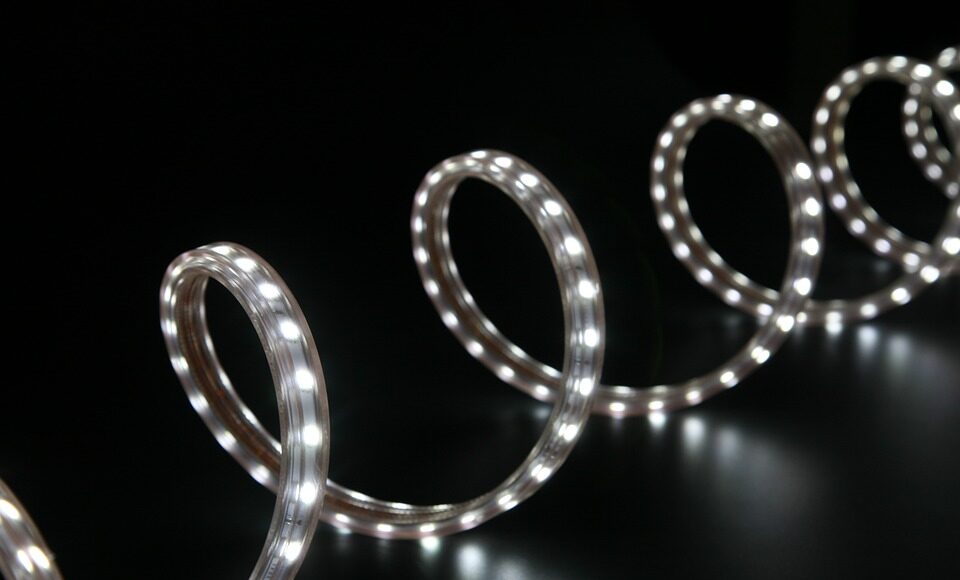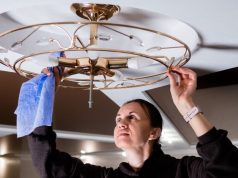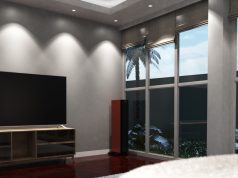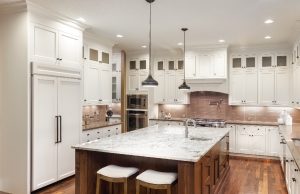LED strip lights are a popular choice among homeowners, as they are versatile, energy-efficient, and have a considerable lifespan when compared to other options available on the market. At the same time, you can cut LED strips into smaller strips, but you could also do the opposite and join several LED strips together.
You can also dim the light, depending on the time of the day and your personal preferences. Although you’ll need some tools to complete your project, if you are wondering how to install LED strip lights, we would like to assure you that it’s not as hard as you might think.
However, it’s not a walk in the park either, but if you conduct research before starting the work, you’ll be just fine. You are in the right place, and after reading this article, you’ll know everything there is to know about installing LED strip lights. Let’s go!
Why Are LED Strip Lights Popular?
LED strip lights run on 12V or 24V, which means that even in the case of an unpleasant accident, there is no need to worry as this voltage isn’t particularly dangerous. It is also possible to find high voltage LED strip lights, with 110V, 230V, or 240V, but they are a completely different animal.
Their voltage is drastically higher, and touching them could have tragic consequences. However, that’s why they are used in places where touching them isn’t a possibility; that is unless someone makes it their goal.
High voltage LED strip lights provide brighter light and can be primarily found outdoors as decorative lighting on buildings. Their installation process is much simpler than that of LED strip lights with 12V or 24V. However, in this guide, we will focus on the low voltage strip lights.
Before we delve into this subject deeper, let’s focus first on why LED strip lights are popular these days:
- If you think that most people who buy LED strip lights do so out of financial reasons, then you are entirely correct. Their price is higher than that of other light sources, but LED lights have an excellent energy-efficiency. As a result, they will help you save money in the long run, as your electricity bills will be reduced. On top of that, LED lights are durable when compared to competitors – on average, their lifespan is around 50,000 hours, which makes them 50 times more durable than incandescent bulbs, and 20 times more than halogen ones. When you combine all of those factors together, you’ll understand why you should install LED strip lights in your home or garden if you want to cut down on utility costs. Additionally, their lower power consumption means that you won’t need expensive power supply units, which could be the case if you were to use other types of lights.
- Low-voltage LED lights are safe because of their voltage, but that’s not all. If you touch a LED light strip, you won’t burn your skin, as they do not reach high temperatures, even if they are turned on for a longer period of time. As a result, the possibility that your kid or incautious adult will burn themselves is lower. However, what’s even more important is that there is virtually no risk of them starting a fire, as they won’t warm up that much.
- We have previously mentioned that LED strip lights have a superior lifespan when compared to other popular sources of light. However, they are also less likely to break or stop working due to adverse weather conditions. It means that if you worry that your lights could fall on the ground, or, if you choose to hang them outside, they might have to withstand windy and rainy conditions, it’s best to choose LED lights.
What to Do before You Install LED Strip Lights?
Now that you know why LED strip lights are so popular let’s proceed to the next part. Before you even go to the store or order LED strip lighting online, you should measure the place where you intend to hang the lights.
Depending on your idea, you might need to cut the LED lights into separate pieces. If you want to hang the LED lighting in several different places, purchasing a single LED strip might be enough. On the other hand, you can also connect separate LED strips using connectors or soldering them, but you would need tools to complete this task.
Once you know where exactly you would like to hang LED strip lighting, and you add up all the measurements, you’ll have an idea of how long a LED strip you’ll need to buy. It is also important to consider the placement of the nearest electrical outlets.
Now, it’s time for you to decide whether you want to buy 12V or 24V LED strip lights. What’s the difference? If you go with the 24V LED lights, they will be brighter; they are also better suited for illuminating larger spaces, as they typically come in larger strips. However, if you are happy with the amount of light that the 12V LEDs provide, your electricity bill will be smaller. There’s also less of a chance that you’ll have to cut them due to their smaller size.
What Power Source Do You Need for LED Strip Lights?
If you have already bought LED strips, it’s time to calculate how much power they will consume. Why? That’s because the lights won’t work unless they are connected to a power source that can handle their voltage.
Let’s say that you need to power a 10-feet LED strip. First, you need to check how much watts it requires per foot. You might not need the entire strip, and if you cut off part of it, you’ll need less energy to power it. Then, multiply this number by the length of the power strip that you’ll actually use.
If the LED strip lights you bought require 4 watts per feet, then you now have to multiply 10 by 4, with the result being 40. However, it doesn’t mean that a 40-watts power supply will be enough. The common recommendation of the experts is to provide a power supply with a 20% higher voltage so that it won’t constantly run at its full capacity.
Remember to use a single unit of measure, or your calculations will be incorrect. On top of that, if you live outside of the United States, the information about the power requirements on the package might be provided using watts per meter.
However, even though the power supply might have enough voltage, you might notice that the LED lights on one end are noticeably dimmer. A power supply with higher wattage won’t fix this problem. That’s because the lights won’t be as bright as a result of a voltage drop.
What Is Voltage Drop and How to Avoid It?
You can solder or use a connector to join several LED strips together. However, if you exceed the recommended length, the voltage at the end of the LED strip will be greatly reduced, and as a result, the strip won’t generate as much light.
You can usually find the information about the maximum length of the LED strip on the packaging – usually, it is 16 feet for 12V lights and 32 feet for 24V ones, but it really depends on the power consumption and the brand, so make sure that you check the exact length.
What if you want to hang 30 feet of LED lights on the wall, and you have bought lights with a maximum length that is lower than that? That’s simple – just divide them into several pieces, and then connect each one of them separately to the power supply.
To reduce the length of the required wire, we recommend placing the power supply in the middle of the LED strips. Just remember not to exceed the wattage of the power supply, and you’ll be fine.
How to Join Multiple Strip Lights Together or Connect Them to a Power Supply Using Connectors?
Separate LED strip lights can be joined together or connected to the power supply with connectors, but if you have the necessary tools, you could also solder them. Separate LED strip lights can be joined together or connected to the power supply with connectors, but if you have the necessary tools, you could also solder them.
Let’s focus on the former method first. To connect two separate pieces, simply clasp 2 separate LED strips into the hippo buckle connector. That’s much simpler than soldering! At the same time, you can easily unclamp the connectors and rearrange the LED strips.
Now, connecting your LED strips to the power supply unit might be very easy or a little bit more difficult depending on whether the PSU comes with a DC plug or open wires, and whether there are copped pads or a DC receptacle at the end of the LED strip.
If you haven’t separated the strips, and there is a DC receptacle at the end, we recommend getting an adapter with a DC plug, so that all that you would have to do is to plug it in.
However, if you are not so lucky, and there are copper pads at the end of the strip, it doesn’t necessarily mean that soldering is the only solution. If your adapter doesn’t have a DC plug, but open wires, use a solderless connector to connect the red wire from the power supply unit with the copper pad on the LED strip marked with ‘+’, and analogously, the black one with the copper pad marked with ‘-’.
You can easily slide the end of the LED strip into the connector. Once you make sure that the metal clamps touch the copper pads, latch it in place. If the lights don’t work, make sure that you have connected the wires with the correct copper pad. If you need to connect more LED strips to a single power supply unit, we recommend using a LED strip splitter.
How to Solder Led Strips Together?
As we have previously mentioned, instead of using connectors, you could solder the LED strips together. Most people would consider this option as the more difficult one. Additionally, if you go with this method, you should remember that it’s more of a permanent solution – you won’t be able to just unclamp the LED strips.
First, you’ll need to purchase 2 0.04 inch thick wires, preferably a red one and a black one as not to add to the confusion. Next, remove about 1/8 of an inch of the casing from both ends of the wires using a wire stripper. If you don’t have it, you could use a knife, but you’ll risk damaging the wire or hurting yourself in the process.
Once the end of the wire is stripped of the casing, slide heat shrink tubing onto it. This way, when the wire will be connected to the LED strip later on, you won’t risk electrocuting yourself.
Now, heat the soldering iron to 350*F so that the wire will melt. When the iron will reach this temperature, solder the wires to the LED strip, or more precisely, to the copper pads. Once the wire has melted, let it cool off.
It doesn’t take much time for the copper to solidify, but please be patient, as you could easily burn your hand if you touch it. We assume that it’s not your first time soldering, but we would like to stress the importance of wearing a face mask and protective glasses.
Before you start soldering, make sure that you know which wire goes where. Now, repeat the procedure with the other end of the wire and another LED strip. Once you are sure that both ends of the wires are melted onto the copper pads on two separate LED strips, heat the shrink tubing.
You could even do so with the soldering iron, but make sure that its temperature isn’t too high and that you don’t actually touch the tubing.
Soldering might be a little more time-consuming and it also requires access to tools, but if you want the LED strips to be firmly connected, it is a better option. You won’t have to worry that the lights will disjoin in adverse conditions.
Similarly, you can solder the LED strips to the power supply unit. If your PSU comes with the DC plug, you will need a female DC adapter and a solderless connector. Usually, connectors come with the wire, but if your model didn’t, you’ll need to buy it separately.
If the PSU has open wires sticking out of its end, then simply solder them to the LED strip, repeating the procedure that we have previously described.
Mounting the Led Strip Lights
If everything works as it should, it’s finally time to install LED strip lights on the wall, or wherever you want. LED light strips come with adhesive backing, which means that you won’t have to use any tools in the mounting process.
However, don’t peel everything at once, or you might find out that some strip lights are now attached to your floor. Before you even start peeling off the adhesive backing, make sure that the surface on which you want to mount the strip lighting is perfectly clean.
If there’s dirt or grease, the LED light strips will likely fall off in the near future. Even if they might not necessarily break, as LED lights are more durable than the glass ones, it could be a little annoying having to attach them frequently.
Usually, it is enough just to wipe the surface with a wet cloth, and then just use a paper towel to make sure it’s completely dry. Once the surface is clean, you can start peeling off the backing of the LED strip lights.
Do it one by one to avoid creating a mess. If the strip lights don’t stick to the surface, you can use mounting clips. It is especially recommended if you want to install LED strip lights somewhere outside so that they won’t fall off even in bad weather.
Conclusion
Many people wonder how to install LED strip lights, and although saying that it’s extremely easy would be a lie, you can certainly do it with some tools and planning. LED light strips come in different colours and are an excellent choice no matter what your goal is.
Regardless of whether you want to enhance the mood in your bedroom, ensure that there is enough light in your kitchen, or maybe decorate your room with LED lights, you can’t go wrong.
Depending on your idea, your project might require very little time; however, it all really depends on the power supply unit’s type and whether you want to divide the LED strips into several pieces. However, even if it won’t be as easy as plugging the power adapter into the LED strip, you won’t necessarily have to solder – you could use solderless connectors instead.
We hope that after reading this article, you know how to install LED strip lights. Yes, it will take some time, but we certainly think that it’s worth the effort. If you have any questions, feel free to contact us, and we’ll be happy to help.













